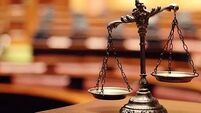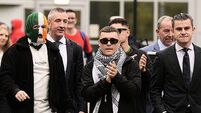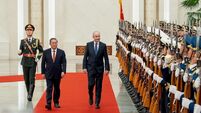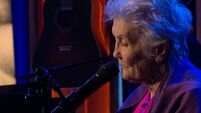Embassy in line of fire
The killings inflamed the whole island of Ireland.
In Dublin, protestors began besieging the British Embassy on Merrion Square. The siege culminated in the burning of the building on Wednesday, Feb 2, 40 years ago today.
The day had been earmarked by the Irish Government as a national day of mourning. Offices, banks and factories, as well as shops, schools and hotels were all shut. Bus, train and taxi services were limited. Even air traffic over the country was suspended for four hours. Black flags, many with the figure 13 superimposed in white, hung from buildings.
The fire began after about 20,000 to 30,000 people descended on Merrion Square as part of a protest. Former Taoiseach Bertie Ahern was among their ranks. In the RTÉ documentary Bertie, screened a few years ago, he recalled being “incensed” and tempted, like many young men of twenty at the time, to join the Provisional IRA, one of the chief instigators of the march.
“People came from all over. Nobody expected such numbers. There was a huge turnout,” says former SIPTU chief Des Geraghty, another demonstrator, who was then working as a transport union official.
“There was a very angry mood. It was a very emotive occasion. There was a lot of very anti-British feeling amongst the protestors, a feeling that the British Embassy should be asked to leave Dublin. The march was an opportunity for people to vent their anger.
“The protestors themselves were quite friendly and cheerful initially. I remember one of the interesting people in the crowd was Dr Moira Woods. The joke that we all remembered afterwards was that her husband’s family actually owned — but had obviously leased — the embassy building, but she didn’t seem to mind being on the other side.”
Four men carrying black flags, accompanied by a band playing the Dead March, led the procession to the embassy. When it reached Merrion Square, a few petrol bombs were hurled at the building over the heads of about 200 gardaí stationed in front and behind.
Rain poured down. Three coffins draped in black were placed on the steps of the embassy. A couple of Union Jack flags were burned, as were pictures of the Prime Minister of Northern Ireland Brian Faulkner and effigies of a British soldier and the British Prime Minister Edward Heath.
Late that afternoon, Minister of Justice Des O’Malley convened a meeting in his St Stephen’s Green office with Jerry Cronin, Minister for Defence; Michael Wymes, Garda Commissioner; and General Seán MacKeown, Chief of Staff of the Irish Army.
“It had become very serious. We discussed what should be done,” he says. “The chief of staff said that the army could save the building if he put in troops. However, they would have had to use live ammunition. He said he could only authorise them provided they were allowed to defend themselves fully.
“Because of the times, there were always soldiers stationed around Leinster House and government buildings. I don’t know how many; maybe 150 to 200. They were billeted close by.
“We had no option but to consider it. The gardaí were unarmed. They were being put in mortal danger. In the end, Jerry Cronin and I decided we better not send in the army. We concluded that it was what the two IRAs — the Official IRA and the Provisionals — wanted.”
Shortly after dusk, the embassy was well aflame. “You could see the glow of fire across the roofs of Merrion Square,” says O’Malley.
Fire engines arriving to fight the blaze were blocked. Their hoses were cut. “Burn, burn, burn,” chanted protesters, who continued to hurl stones and missiles as well as petrol bombs. Every window in sight was smashed. Whenever the fire broke into new parts of the building, the cheering increased. Rioting broke out. Protestors were baton charged by gardaí. About 30 people, including gardaí, were injured.
After the building finally succumbed to the fire, the protestors began to disperse. “There was definitely support for it when it burned,” says Geraghty. “Clearly, there was a lot of excitement. There was cheering, but people scattered then in various directions. It was quite an amazing sight alright.”
The Government agreed to pay compensation for the damage. The British government, however, was enraged by what was referred to as “the sacking of the embassy” in House of Commons debates the following day.
Leading the parliamentary discussions, Sir Alec Douglas-Home, the Secretary of State for Foreign and Commonwealth Affairs, was particularly upset because, in his words, “the authorities had ample warning of the danger, both through the build-up of the crowd’s activities and through specific warnings conveyed during the early evening of the 1st of February.”
“Clearly it radically deteriorated Anglo-Irish relations,” says O’Malley. “The Arms Crisis, for example, was potentially more dangerous from the State’s point of view. What happened in Merrion Square was a spontaneous reaction to the murder of 13 people in Derry. It was stoked up by the two IRAs.
“Happily, it was a case of what wasn’t done, rather than what could have been done differently. The building could have been saved, but certainly at the cost of lives. Fortunately, we made the right decision.”
IT was the annus horribilis. There was an average of 30 shootings a day in 1972. Almost 500 people were killed in the year, with 5,000 injured, but the statistics don’t do justice to the horror unleashed.
Early in March, for example, the IRA bombed a city centre pub in Belfast, the Abercorn. “Two sisters have both been seriously maimed,” recorded a local newspaper. “One, who planned to marry, has lost both legs, an arm and an eye. Her sister has lost both legs. Last night their mother was under sedation.”
July was the worst month of the year — almost 100 people died; nine of them on Bloody Friday. Between 2.10pm and 3.15pm on the afternoon of Jul 21, 1972, the IRA exploded 19 bombs with “vague and useless” warnings, according to a Guardian correspondent, across Belfast city. Men and women wept openly in the streets as they huddled together in shock. David Ervine, the former leader of the Progressive Unionist Party, who was 19 years of age, enlisted, among others, for the UVF following the day of carnage.
The year began with Bloody Sunday in Derry — 13 people were killed on 30 January (another was fatally injured) when the British Army’s Parachute Regiment opened fire on a civil rights march.
The sight of Catholic priest Edward Daly, who later became Bishop of Derry, vainly fluttering a white handkerchief in the air, has become one of the iconic images of the war. When he heard the opening volley of shots he began to run. He recalled seeing a 17-year-old youth laughing at the sight of a priest running. A second later, he heard a gasp. The boy threw his hands in the air and fell on his face. He ran over to him, and as he administered the last rites, the boy asked him: “Am I going to die?”
















